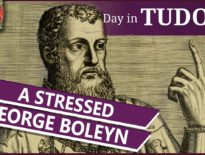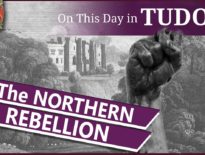On this day in Tudor history, 10th November 1556, English explorer and navigator, Richard Chancellor, was killed. Chancellor is known as being the first foreigner to enter the White Sea and to establish relations with Russia and Tsar Ivan IV, or Ivan the Terrible.
Chancellor was sadly drowned after saving the Russian ambassador, Osip Napeya, when their ship, The Edward Bonaventure, was wrecked just off the Aberdeenshire coast of Scotland.
Find out about Richard Chancellor's life, career and sad end in today's talk.
May 10 - A search for the Northeast Passage finds Ivan the Terrible instead:
Also on this day in Tudor history, 10th November 1536 (some sources say 1537), Sir Henry Wyatt of Allington Castle, politician, courtier, Privy Councillor and father of poet Sir Thomas Wyatt the Elder, died. Sir Henry Wyatt was an important man, but rather than tell you about his career, in last year’s video I shared two interesting stories concerning this Tudor man and cats, pigeons and a lion.
Also on this day in history:
- 1483 - Birth of reformer, priest and theologian Martin Luther at Eisleben, Saxony. He was the son of Hans and Margarethe Luther (or Luder). Luther was a crucial figure in the European Reformation and is known for his “Ninety-Fives Theses” (or “Disputation of Martin Luther on the Power and Efficacy of Indulgences”) of 1517 and his teaching of justification by faith, i.e. that salvation came as a gift of God's mercy from faith in Jesus Christ and that it could not be earned by good works.
- 1542 – Death of Sir Richard Pollard, law reporter, member of Parliament and King's Remembrancer of the Exchequer.
- 1565 - Elizabeth I's favourite, Robert Devereux, 2nd Earl of Essex, was born at Netherwood, Herefordshire. Devereux was the eldest son of Walter Devereux, 1st Earl of Essex, and Lettice Knollys, granddaughter of Mary Boleyn, and was a favourite of Elizabeth I.
- 1597 – Death of Peter Wentworth, member of Parliament, in the Tower of London. He had been imprisoned in 1593 after drafting the treatise “A Pithie Exhortation to her Majestie for Establishing her Successor to the Crowne” on the royal succession.
- 1610 – Death of Sir Thomas Wilford, member of Parliament and soldier, at his home in Hedding, Kent. He served as a soldier in Ireland, the Low Countries and France. His offices included Deputy Lieutenant of Kent and Governor of Camber Castle.
Transcript:
On this day in Tudor history, 10th November 1556, English explorer and navigator, Richard Chancellor, was killed.
Chancellor was drowned after saving the Russian ambassador, Osip Napeya, when their ship, The Edward Bonaventure, was wrecked in Pitsligo Bay, just off the Aberdeenshire coast.
Chancellor is known as being the first foreigner to enter the White Sea and to establish relations with Russia.
I’ll give you a link to my talk on the search for the Northeast Passage, a voyage led by Chancellor, Sebastian Cabot and Sir Hugh Willoughby in 1553, but today I just wanted to give you a few facts about Chancellor and his sad end.
• We don’t know anything about Chancellors’s birth or even his family, but his contemporary Clement Adams recorded that he was brought up in the household of Sir Henry Sidney.
• In 1550, Chancellor sailed on a voyage organised by Sebastian Cabot to the Levant, as an apprentice pilot under Roger Bodenham. It was a voyage designed to give English mariners more experience. It certainly helped train Chancellor for his 1553 voyage.
• In 1553, Chancellor was appointed pilot general of a voyage to find a Northeast passage to help the trade of English cloth to the Far East. He was also appointed as captain of the 160 ton Edward Bonaventure, the largest of the three ships sent.
• As I explained in my talk from 10th May, this voyage, which Chancellor undertook with Sebastian Cabot and Sir Hugh Willoughby, failed in its aim of finding a Northeast Passage to the Far East, but, instead, in the winter of 1553/4, Chancellor was able to come to a very beneficial trade agreement with Tsar Ivan IV of Russia, Ivan the Terrible.
• Chancellor returned to England in 1554 and was able to give his friend, Clement Adams, lots of information on Russia. He then commanded a voyage for the newly founded Russia Company, or Muscovy Company, which left in May 1555, to take letters of privilege and merchants’ factors to Ivan. Two ships, the Philip and Mary, and the Edward Bonaventure, were sent. Chancellor spent the winter of 1555 at Ivan’s court at Moscow, and then, in July 1556 set off from St Nicholas with his two original ships, along with the Bona Esperanza and Bona Confidentia from the original 1553 voyage, which had been discovered with Willoughby and his crew who had sadly frozen and starved to death. They sailed with rich cargo and also an embassy from Ivan.
• Unfortunately, the Bona Esperanza and Bona Confidentia were both lost in bad weather off the coast of Norway, and then Chancellor’s ship, the Edward Bonaventure, which was also carrying the Russian ambassador, Osip Napeya, was caught in a storm and was wrecked in Pitsligo Bay, just off the Aberdeenshire coast of Scotland on this day in 1556. According to the Russian ambassador, Chancellor saved the ambassador and his entourage using the ship’s boat, but he himself sadly drowned.
• We don’t know who Chancellor’s wife was, but he had two sons, one of whom, Nicholas, spent several years working for the Muscovy Company in Russia, before serving as a purser in navigator Martin Frobisher’s three voyages in the late 1570s, and Edward Fenton’s 1582 voyage, and as a merchant in a 1580 voyage. Nicholas died of a fever in Sierra Leone in September 1582.
• Chancellor recorded his observations of Russia, including its topography, along with an account of his first meeting with Ivan IV, and details on the Russian court, in his “booke of the great and mighty Emperor of Russia, etc”.
His drowning seems such a sad end to an exciting life, doesn’t it?



Leave a Reply